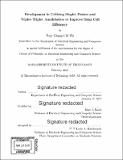| dc.contributor.advisor | Marc A Baldo. | en_US |
| dc.contributor.author | Wu, Tony Chang-Chi | en_US |
| dc.contributor.other | Massachusetts Institute of Technology. Department of Electrical Engineering and Computer Science. | en_US |
| dc.date.accessioned | 2018-05-23T16:34:39Z | |
| dc.date.available | 2018-05-23T16:34:39Z | |
| dc.date.copyright | 2018 | en_US |
| dc.date.issued | 2018 | en_US |
| dc.identifier.uri | http://hdl.handle.net/1721.1/115783 | |
| dc.description | Thesis: Ph. D., Massachusetts Institute of Technology, Department of Electrical Engineering and Computer Science, 2018. | en_US |
| dc.description | Cataloged from PDF version of thesis. | en_US |
| dc.description | Includes bibliographical references (pages 107-113). | en_US |
| dc.description.abstract | Our main energy source are burning fossil fuels. Solar energy is a clean, sustainable energy source that does not emit greenhouse gas that causes global warming. In this thesis, singlet fission and triplet-triplet annihilation would be discussed and studied to increase solar cell power conversion efficiency. Singlet fission splits a singlet exciton into two lower energy triplet excitons. This energy down conversion is efficient and have shown near 200% triplet exciton yield. With energy down conversion, thermalization loss in solar cell could be reduced. We have shown singlet fission in tetracene, a suitable down conversion fission material to pair with silicon solar cell, up to 127% of internal quantum yield. To integrate tetracene as the energy down converter for silicon, we have demonstrated triplet exciton transfer from tetracene to silicon with WNx passivation. To show triplet exciton transfer, a spectrally resolved magnetic field effect measurement setup was designed and built. We have also demonstrated a metal-free, solid state optical up conversion system. This is in contrast with most optical up conversion system that uses heavy metal for triplet generation and are limited to solution fabrication based on material restrictions. The novel optical up conversion system provided cheaper material choices as well as better fabrication freedom and potentially longer device operation lifetime. | en_US |
| dc.description.statementofresponsibility | by Tony Chang-Chi Wu. | en_US |
| dc.format.extent | 113 pages | en_US |
| dc.language.iso | eng | en_US |
| dc.publisher | Massachusetts Institute of Technology | en_US |
| dc.rights | MIT theses are protected by copyright. They may be viewed, downloaded, or printed from this source but further reproduction or distribution in any format is prohibited without written permission. | en_US |
| dc.rights.uri | http://dspace.mit.edu/handle/1721.1/7582 | en_US |
| dc.subject | Electrical Engineering and Computer Science. | en_US |
| dc.title | Development in utilizing singlet fission and triplet-triplet annihilation to improve solar cell efficiency | en_US |
| dc.type | Thesis | en_US |
| dc.description.degree | Ph. D. | en_US |
| dc.contributor.department | Massachusetts Institute of Technology. Department of Electrical Engineering and Computer Science | |
| dc.identifier.oclc | 1036987791 | en_US |
